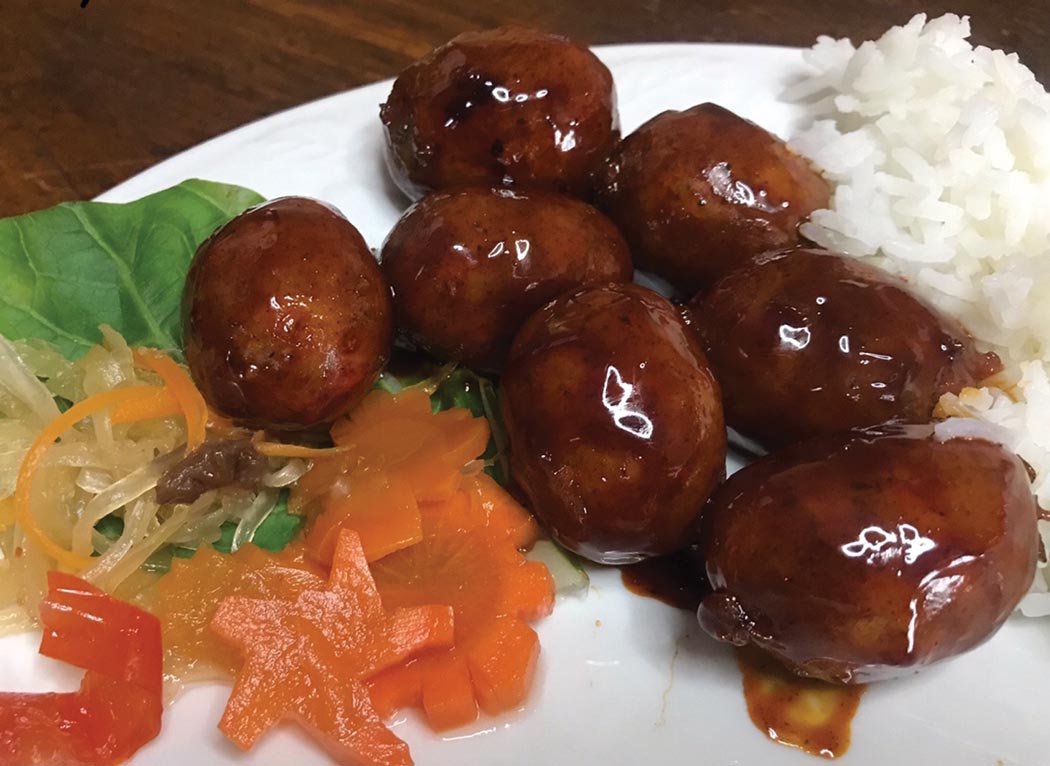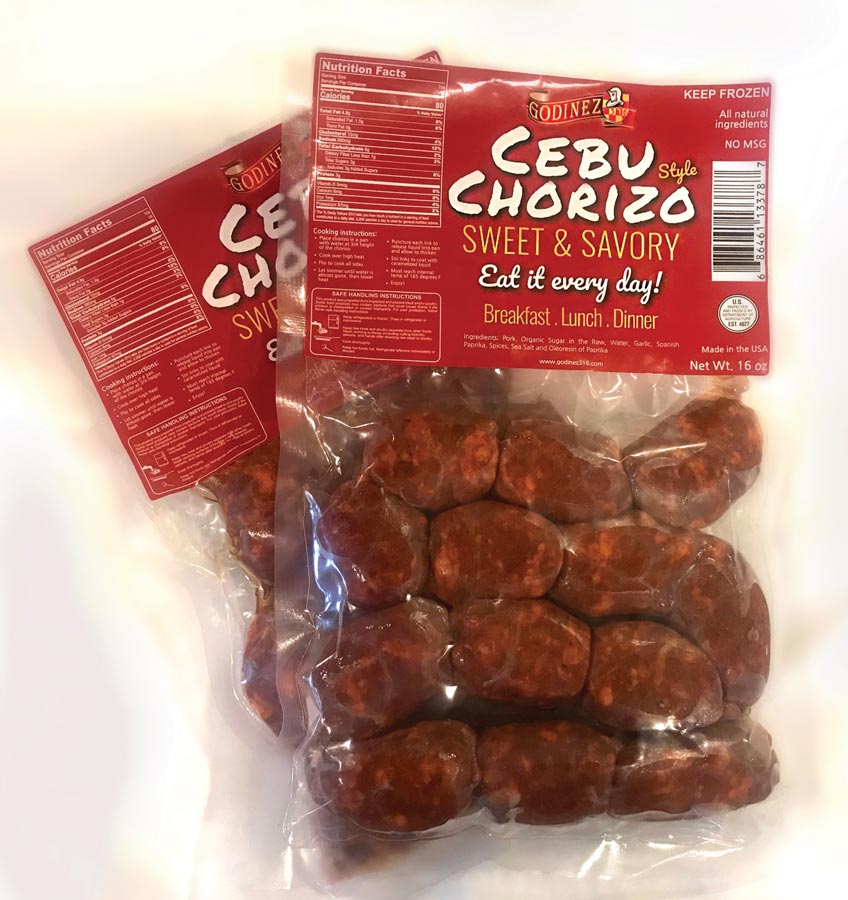
FILIPINO cuisine is no stranger to sausages, more commonly known in the Philippines as “longganisa.” Derived from the Spanish term “longaniza,” the country offers several interpretations of the dish from different regions.
Most kinds of local longganisa fall under two categories: “recado,” which refers to a more savory, salty kind of sausage; and “hamonado,” which refers to a sweeter sausage.
Chorizo de Cebu, which is one of the most popular versions of Filipino longganisa, is of the hamonado type. It is circular in shape and red in color, due to the use of achuete seeds, and is often paired with fried rice and egg, making it perfect for any meal of the day.
Becca Godinez, famed Filipina singer and performer, shares how she developed her rendition of the chorizo.
For those living in the U.S., Godinez316 Cebu Style chorizo, which uses all-natural ingredients and contains no preservatives, is now available in several Seafood City Supermarkets as follows:
Southern California: Carson, Cerritos, Chula Vista, Eagle Rock, Irvine, Los Angeles (Vermont), Mira Mesa, National City, North Hills, Rancho Cucamonga, and West Covina.
Northern California locations are: Concord, Hayward, Milpitas, Sacramento, South San Francisco, Union City and Vallejo.
Outside of California: Las Vegas, Seattle, Washington, and Waipahu, Hawaii.
It is also available at Manila Seafood in National City.

Asian Journal (AJ): Tell us about Godinez316 Cebu Style Chorizos — how long was the process of developing your recipe before they went out onto shelves?
Becca Godinez (BG): I have been cooking up the idea of developing Cebu Style Chorizos even as I was developing my Premium Chorizo de Bilbao, which went to market in November 2019 and is available in all Seafood City locations. I learned about chorizos specific to Cebu about four years ago and was eager to try and make my own. There were, however, limitations in trying to create a flavor profile for the chorizo here in California because I had nothing to compare it with. There are USDA/FDA limitations regarding the importation of meat products from overseas so I had to depend on what I was able to find locally. I even tried to get some friends coming back from Manila (pre-COVID) to bring me some — but that was not possible either. In truth, there were only four chorizo makers that I taste-tested prior to beginning my own journey.
I pored over every possible recipe and video that I could find on the internet that identified as a Cebu chorizo.
After some time, I was able to whittle them down to three groups that used specific ingredients in their end products. One of them was a complete no-no…the ones that used anise in the meat mass. I do not much care for anise so that went out the window.
Developing my version began after a personal “health” incident in April. With a new lease on life, I figured I’d better do this now or I never will. Although many gave suggestions as to what ingredients would work best, I had to first consider availability. One or two of the ingredients that I wanted to use were Filipino ingredients and I was uncertain as to their bulk availability here in CA. I had to forego those. Working with my manufacturer, we agreed on the grind size, and on the fat to lean meat ratio. The rest was up to me. In order to take on the unique Cebu chorizo shape, I taught myself how to stuff and string tie the links into the desired shapes. A true Cebu Style Chorizo is either round or a rounded oblong and must result in a reddish-brown end product with caramelization on the outer skin. After this personal at-home process I worked with the manufacturer to measure the exact size and weight of each link to total the 16 oz that each commercial packet would eventually weigh.

The vision began much earlier but I would say that the actual physical creation journey began in May 2020 and I found my final and best flavor in August. I have to stress that this is MY version of the chorizo. This product went through several editions with test groups giving me their comments on recipes that I was testing out. I approached the process with much respect to the Cebuanos and to the Cebuano tradition.
Further steps involved submitting the ingredients for the Nutritional Analysis with the FDA. Finally, I worked closely with an awesome graphics designer in coming up with my logo and label design. Start to finish – seven months. It went to market the week of Christmas 2020.
AJ: What makes Cebu Style Chorizos different from others on the market?
BG: It is definitely NOT longaniza. Anyone trying it for the first time will know that they are experiencing a new flavor. It is sweet and savory — it has good spices for what many have characterized as carrying a good “umami” with each bite. My Cebu Style Chorizo uses 100% natural ingredients. I use NO preservatives and the manufacture is semi-artisanal. It is a great-tasting chorizo that can be eaten every day and it can be served for breakfast, lunch or dinner.
AJ: Where can customers find your chorizos? What’s in store for your brand in 2021?
BG: Right now, the product should be in most of the Seafood City Supermarkets following a very successful test run in only four outlets. I am so very happy to say that during the initial run, Las Vegas sold out in less than a week and they quickly submitted a re-order.
Cerritos was not far behind. It is my hope, my dream to get this out to all markets and that dream will be fulfilled this week. Folks have also clamored for these to be made available in Florida, Arizona, New York, Washington to name a few. You can bet that my heart soared at the requests. I will work with my distributor, Food For All, to try to make this a reality soon. The desire is to make the Cebu Style Chorizo a pick-it-up from the shelf without thinking product. A recognized, meal-time standard — that’s the dream anyway.
AJ: Some ways to prepare and serve the chorizos?
BG: I made sure to include preparation instructions on the label. Basically, you pour water into a pan and fill it to ¾ the height of the chorizo. Turn the heat to high and flip the links as they cook. Once the liquid is about gone, lower the heat then pierce the bottom of each link to release liquid. Allow the liquid to thicken and caramelize – stirring the links until they are coated in a deep red brown color. Snip each link and transfer to your serving tray.
My heart hopes that folks do try this Cebu Style Chorizo and that they make it part of their regular day-to-day food fare. Lami lagi ni kaayo!






